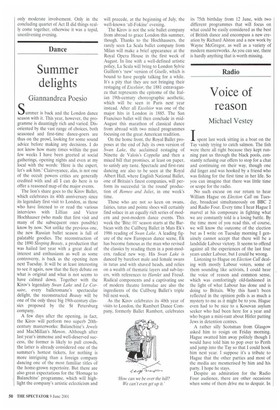Summer delights
Giannandrea Poesio
Summer is back and the London dance season with it. This year, however, the programme is dauntingly rich and varied. Disoriented by the vast range of choices, both seasoned and first-time dance-goers are thus on the prowl, looking for some sound advice before making any decisions. I do not know how many times within the past few weeks I have been greeted at social gatherings, opening nights and even at my local with the words: 'Here is the expert, let's ask him.' Clairvoyance, alas, is not one of the occult powers critics are generally credited with and all I can do here is to offer a reasoned map of the major events.
The lion's share goes to the Kirov Ballet, which celebrates its 40th anniversary since its legendary first visit to London, as those who have listened to or read the various interviews with Lillian and Victor Hochhauser (who made that first visit and many of the subsequent ones possible) know by now. Not unlike the previous one, the new Russian ballet season is full of palatable goodies. The reconstruction of the 1890 Sleeping Beauty, a production that was hailed last year with a great deal of interest and enthusiasm as well as some controversy, is back as the opening item next Tuesday. It will be at least interesting to see it again, now that the fiery debate on what is original and what is not seems to have calmed down. Together with the Kirov's legendary Swan Lake and Le Corsaire, every balletomane's spectacular delight, the reconstructed Beauty will be one of the only three big 19th-century classics proposed by the St Petersburg company.
A few days after the opening, in fact, the Kirov will perform two superb 20thcentury masterworks: Balanchine's Jewels and MacMillan's Manon. Although after last year's immense and well-deserved success, the former is likely to pull crowds, the latter is already considered one of the summer's hottest tickets, for nothing is more intriguing than a foreign company dancing one of the most familiar titles of the home-grown repertoire. But there are also great expectations for the 'Homage to Balanchine' programme, which will highlight the company's artistic eclecticism and
will precede, at the beginning of July, the well-known 'all-Fokine' evening.
The Kirov is not the sole ballet company from abroad to grace London this summer, though. Thanks to the Hochhausers, the rarely seen La Scala ballet company from Milan will make a brief appearance at the Royal Opera House in the first week of August. In line with a well-defined artistic policy, La Scala will bring to London Syline Guillem's 'new. version of Giselle, which is bound to have people talking for a while. It's a pity that they are not bringing their restaging of Excelsior, the 1881 extravaganza that represents the epitome of the Italian 19th-century choreographic aesthetic, which will be seen in Paris next year instead. After all Excelsior was one of the major hits in London in 1885. The San Francisco ballet will then conclude in midAugust this marathon of classical dance from abroad with two mixed programmes focusing on the great American tradition.
On the home front, the Royal Ballet proposes at the end of July its own version of Swan Lake, the acclaimed restaging of Ninette de Valois's Coppelia and then a mixed bill that promises, at least on paper, to satisfy any taste. Spectacle and first-rate dancing are also to be seen at the Royal Albert Hall, where English National Ballet, one of Britain's finest companies, will perform its successful 'in the round' production of Romeo and Juliet, in one week's time.
Those who are not so keen on swans, fairies, tutus and pointe shoes will certainly find solace in an equally rich series of modern and post-modern dance events. This week the 'Bite: 01' season starts at the Barbican with the Cullberg Ballet in Mats Ek's 1986 reading of Swan Lake. A leading figure of the new European dance scene, Ek has become famous as the man who revised the classics by reading them in a post-modern, radical new way. His Swan Lake is danced by barefoot male and female swans in tutus and with shaved heads, and relies on a wealth of thematic layers and sub-layers, with references to Hamlet and Freud. Radical components and a captivating use of modern theatre formulae are also the ingredients of the Cullberg Ballet's triple bill next week.
As the Kirov celebrates its 40th year of visits to London, the Rambert Dance Company, formerly Ballet Rambert, celebrates
its 75th birthday from 12 June, with two different programmes that will focus on what could be easily considered as the best of British dance and encompass a new creation by Richard Alston and a new work by Wayne McGregor, as well as a variety of modern masterworks. As you can see, there is hardly anything that is worth missing.


































































 Previous page
Previous page